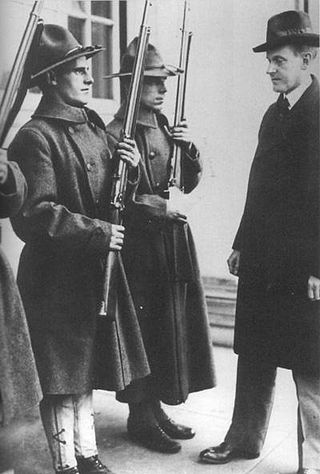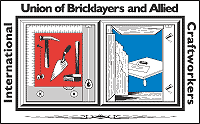
A roof is the top covering of a building, including all materials and constructions necessary to support it on the walls of the building or on uprights, providing protection against rain, snow, sunlight, extremes of temperature, and wind. A roof is part of the building envelope.
Industrial unionism is a trade union organising method through which all workers in the same industry are organized into the same union, regardless of skill or trade, thus giving workers in one industry, or in all industries, more leverage in bargaining and in strike situations.

The American Federation of Labor was a national federation of labor unions in the United States that continues today as the AFL–CIO. It was founded in Columbus, Ohio, in 1886 by an alliance of craft unions eager to provide mutual support and disappointed in the Knights of Labor. Samuel Gompers was elected the full-time president at its founding convention and was re-elected every year except one until his death in 1924. He became the major spokesperson for the union movement.

The United Steel, Paper and Forestry, Rubber, Manufacturing, Energy, Allied Industrial and Service Workers International Union, commonly known as the United Steelworkers (USW), is a general trade union with members across North America. Headquartered in Pittsburgh, the United Steelworkers represents workers in Canada, the Caribbean, and the United States. The United Steelworkers represent workers in a diverse range of industries, including primary and fabricated metals, paper, chemicals, glass, rubber, heavy-duty conveyor belting, tires, transportation, utilities, container industries, pharmaceuticals, call centers and health care.

The International Brotherhood of Electrical Workers (IBEW) is a labor union that represents approximately 775,000 workers and retirees in the electrical industry in the United States, Canada, Guam, Panama, Puerto Rico, and the US Virgin Islands; in particular electricians, or inside wiremen, in the construction industry and lineworkers and other employees of public utilities. The union also represents some workers in the computer, telecommunications, and broadcasting industries, and other fields related to electrical work.

The United Brotherhood of Carpenters and Joiners of America, often simply the United Brotherhood of Carpenters (UBC), was formed in 1881 by Peter J. McGuire and Gustav Luebkert. It has become one of the largest trade unions in the United States, and through chapters, and locals, there is international cooperation that poises the brotherhood for a global role. For example, the North American Chapter has over 520,000 members throughout the continent.

Boston police officers went on strike on September 9, 1919. They sought recognition for their trade union and improvements in wages and working conditions. Police Commissioner Edwin Upton Curtis denied that police officers had any right to form a union, much less one affiliated with a larger organization like the American Federation of Labor (AFL), which some attribute to concerns that unionized police would not protect the interest of city officials and business leaders. Attempts at reconciliation between the Commissioner and the police officers, particularly on the part of Boston's Mayor Andrew James Peters, failed.

Waterproofing is the process of making an object or structure waterproof or water-resistant so that it remains relatively unaffected by water or resisting the ingress of water under specified conditions. Such items may be used in wet environments or underwater to specified depths.

The Seafarers International Union or SIU is an organization of 12 autonomous labor unions of mariners, fishermen and boatmen working aboard vessels flagged in the United States or Canada. Michael Sacco was been its president from 1988 until 2023. The organization has an estimated 35,498 members and is the largest maritime labor organization in the United States. Organizers founded the union on October 14, 1938. The Seafarers International Union arose from a charter issued to the Sailors Union of the Pacific by the American Federation of Labor as a foil against loss of jobs to the Congress of Industrial Organizations (CIO) and its Communist Party-aligned faction.

The Steel Strike of 1919 was an attempt by the American Federation of Labor to organize the leading company, United States Steel, in the American steel industry. The AFL formed a coalition of 24 unions, all of which had grown rapidly during World War I. In the lead role would be the Amalgamated Association of Iron, Steel and Tin Workers (AA) with a five-member steering committee. The strike began on September 22, 1919, and finally collapsed on January 8, 1920. The opposition led by Elbert H. Gary, president of U.S. Steel had triumphed.

The International Union of Bricklayers and Allied Craftworkers (BAC) is a labor union in the United States and Canada which represents bricklayers, restoration specialists, pointers/cleaners/caulkers, stonemasons, marble masons, cement masons, plasterers, tile setters, terrazzo mechanics, and tile, marble and terrazzo finishers. The union is an affiliate of the AFL–CIO and its Building and Construction Trades Department. It is also affiliated with the Canadian Labour Congress in Canada.
The Structural Building Trades Alliance (SBTA) was an American federation of labor unions in the construction industry. It was founded in 1903 and existed until 1908, when it affiliated with the American Federation of Labor (AFL) and became the Building Trades Department.

Bituminous waterproofing systems are designed to protect residential and commercial buildings. Bitumen is a material made up of organic liquids that are highly sticky, viscous, and waterproof. Systems incorporating bituminous-based substrates are sometimes used to construct roofs, in the form of "roofing felt" or "roll roofing" products.

The American Federation of State, County and Municipal Employees (AFSCME) is the largest trade union of public employees in the United States. It represents 1.3 million public sector employees and retirees, including health care workers, corrections officers, sanitation workers, police officers, firefighters, and childcare providers. Founded in Madison, Wisconsin, in 1932, AFSCME is part of the AFL–CIO, one of the two main labor federations in the United States. AFSCME has had four presidents since its founding.
The International Labor Defense (ILD) (1925–1947) was a legal advocacy organization established in 1925 in the United States as the American section of the Comintern's International Red Aid network. The ILD defended Sacco and Vanzetti, was active in the anti-lynching, movements for civil rights, and prominently participated in the defense and legal appeals in the cause célèbre of the Scottsboro Boys in the early 1930s. Its work contributed to the appeal of the Communist Party among African Americans in the South. In addition to fundraising for defense and assisting in defense strategies, from January 1926 it published Labor Defender, a monthly illustrated magazine that achieved wide circulation. In 1946 the ILD was merged with the National Federation for Constitutional Liberties to form the Civil Rights Congress, which served as the new legal defense organization of the Communist Party USA. It intended to expand its appeal, especially to African Americans in the South. In several prominent cases in which blacks had been sentenced to death in the South, the CRC campaigned on behalf of black defendants. It had some conflict with former allies, such as the NAACP, and became increasingly isolated. Because of federal government pressure against organizations it considered subversive, such as the CRC, it became less useful in representing defendants in criminal justice cases. The CRC was dissolved in 1956. At the same time, in this period, black leaders were expanding the activities and reach of the Civil Rights Movement. In 1954, in a case managed by the NAACP, the US Supreme Court ruled in Brown v. Board of Education that segregation of public schools was unconstitutional.

North America's Building Trades Unions (NABTU) is a labor federation of 14 North American unions in the building trade, founded by the American Federation of Labor in 1907.
The United Brick and Clay Workers of America (UBCWA) was a labor union representing brickmakers, clay and terracotta workers and clay miners in the United States.
The Tile, Marble, Terrazzo, Finishers', Shopworkers' and Granite Cutters' International Union (TMT) was a labor union representing construction workers who used marble and similar decorative materials, in the United States and Canada.













